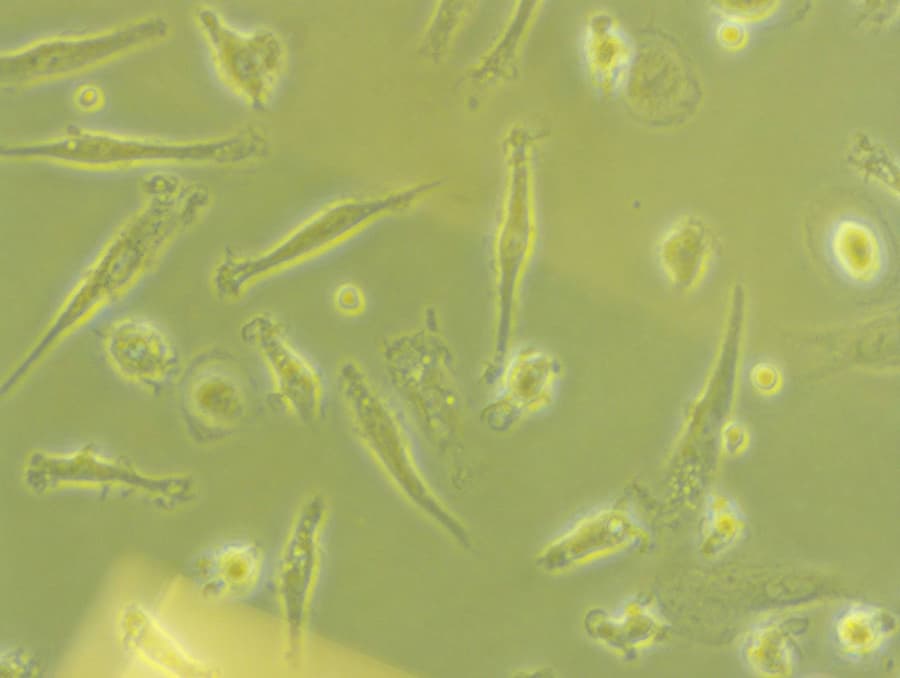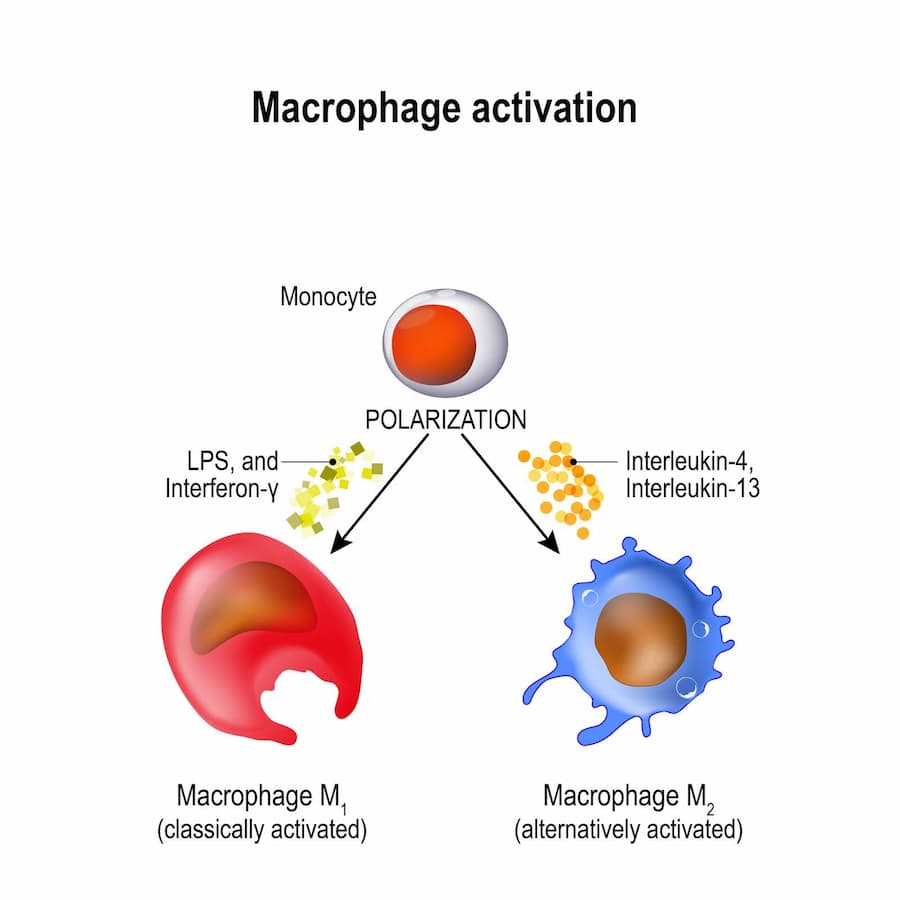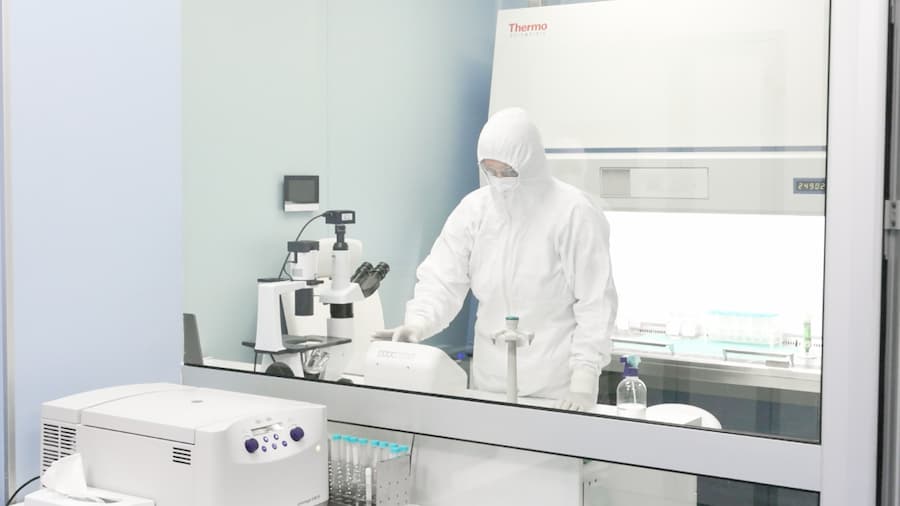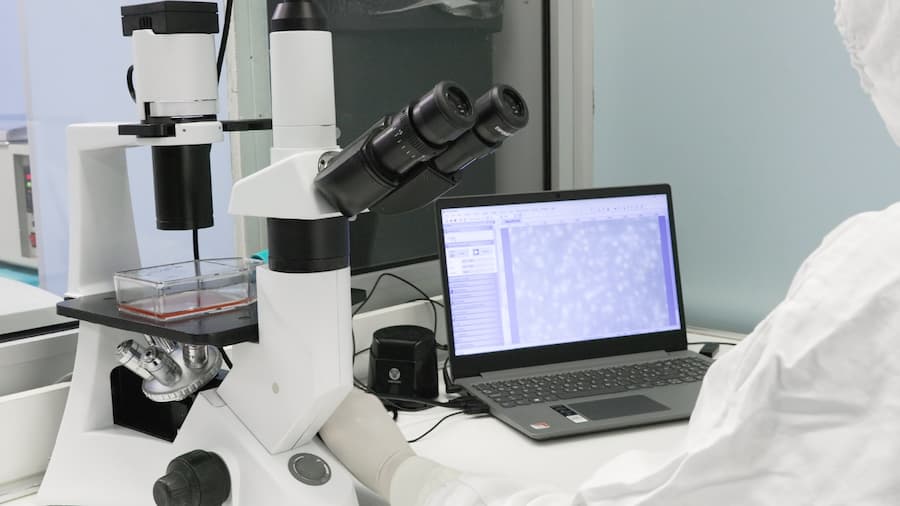Macrophage cells are a type of white blood cell that helps the immune system respond to infections and tissue damage. They are commonly known as “big eaters” due to their remarkable ability to engulf and destroy harmful invaders, such as bacteria, viruses, and dead cells. But beyond this, macrophages play an important role in the progression of inflammatory diseases.
How Do Macrophages Work?
Monocytes, the precursors to macrophages, exit the bone marrow and enter the bloodstream. Once they detect an inflammation source, they migrate out of the bloodstream and into the affected tissues. Within the tissues, macrophage cells can differentiate into various forms depending on local growth factors, cytokines, and microbial products.
There are two primary functional subpopulations of macrophage cells:
- M1 macrophages are involved in fighting infections and initiating immune responses,
- M2 macrophages help to resolve inflammation and repair tissues.
Thanks to these distinct properties, M2 macrophages are used in stem cell therapy.

Get a free online consultation
Don’t feel like reading the whole article in search of answers to your specific questions? Why not discuss them directly with a medical advisor at Swiss Medica? Our experts are here to provide clarity and ensure you’re fully informed.

Medical Advisor, Swiss Medica doctor
When We Use M2 Macrophages in Therapy
Typically, macrophage cell therapy is used in conjunction with other regenerative methods, such as mesenchymal stromal cells and their derivatives.
How do macrophages work? M2-type alternatively activated macrophages exhibit several key properties in the nervous system:
- Anti-inflammatory activity
- Mediation of neuroprotection
- Promotion of neurogenesis (growth of new neurons) and angiogenesis (formation of new blood vessels)
- Support of neuronal plasticity
- Contribution to axon remodeling
Macrophage cell therapy may be beneficial for the following conditions:
| Cerebral palsy (CP) | A group of permanent movement disorders that appear in early childhood. |
| Stroke (outside acute phase) | This category includes strokes that do not occur at the time of treatment. |
| Autism | A developmental disorder characterized by difficulties with social interaction, communication, and repetitive behaviors. |
| Liver cirrhosis | A late stage of scarring (fibrosis) of the liver caused by many forms of liver diseases and conditions, such as hepatitis and chronic alcoholism. |
| Atherosclerosis | Plaques, which are composed of cholesterol, fatty deposits, cellular waste products, calcium, and fibrin, are produced as a result of this complex issue. They block and narrow arteries, making it difficult for blood to flow through |
Intrigued by the mechanics of stem cell therapy?
Discover the details in our dedicated article.
Macrophages Cell Collection and Preparation
In macrophage therapy, we typically use autologous cells. We take a subset of macrophages from the patient’s bloodstream and polarize them all into M2 macrophages. Thus, they acquire anti-inflammatory properties and promote tissue repair and wound healing.

There are three major stages for preparing cells for macrophage therapy:
1st stage. Cell preparation
For cell preparation, we collect blood—around 20 ml. Dosages are determined individually by the doctor.
2nd stage. Polarization
The macrophages are then polarized, which is the process of stimulating them to adopt a specific functional phenotype, in this case anti-inflammatory (M2), and secreted factors (secretomes/exosomes). This preparation process takes 8–10 days.
3rd stage. Preservation
Now in the laboratory, it is possible to cryopreserve macrophages and thaw them 6 days before the patient arrives. This allows us to save them until the patient’s next visit and reduce treatment time.
If the patient’s own macrophages are not suitable for use, it is possible to utilize the secretome of macrophages from a relative, such as the child’s mother.


Take a look at our on-site laboratory, where we grow and produce stem cells.
Have a glimpseHow Do We Deliver the Macrophages
We use two main methods to deliver the patient’s own macrophages:
- Intrathecal—directly into the spinal canal.
- Intravenous—injection into a vein.
Nasal drop administration. Secretome derived from the patient’s cells and, in some cases, from a relative’s cell is administered via nasal drops and given to the patient for maintenance therapy at home.
Dosages
We take great care to measure the exact number of cells required for each individual case, leaving no room for error. The number of macrophages in samples from adults and children varies, ranging from 20 to 60 million cells. Because these cells are not cultured in the laboratory, the amount collected equals the amount given. Cells can be administered completely or partially frozen and stored until the patient’s next arrival.
Macrophage secretome is provided in quantities of 20 vials, each containing 2 ml of secretion. They are used as part of maintenance therapy, which the patient continues to receive after discharge from the hospital.
Expected Time for Treatment Results
How do macrophages work for different conditions? The treatment’s effects differ from person to person because it is used in conjunction with other procedures such as stem cell therapy, IMR, physiotherapy, and others. For most conditions, the effect of therapy lasts from 1 to 3 months after starting the complex treatment. More information about expected outcomes for various conditions can be found on our dedicated page.
Explore how combining therapies like stem cell treatment, kinesiotherapy, manual therapy, and other procedures can enhance your results. Visit our page for full details on our additional procedures.
Explore nowSide Effects of the Macrophage Therapy
M2 macrophage therapy has no serious side effects—they do not pose a risk of inflammation following administration. Some side effects may occur during or after the complex treatment procedure, such as a temporary fever or headaches that can be treated with pain relievers and rest.
Contact us
With an online consultation, you can explore the benefits, costs, and duration of macrophage cell therapy tailored to your case—obligation-free.

Medical Advisor, Swiss Medica doctor
Ready to Explore More?
Discover the full potential of stem cells and dive into additional articles.
List of References:
Mantovani A, Biswas SK, Galdiero MR, Sica A, Locati M. Macrophage plasticity and polarization in tissue repair and remodelling. J Pathol. 2013 Jan;229(2):176-85. doi.org/10.1002/path.4133
Chernykh E, Shevela E, Kafanova M, Sakhno L, Polovnikov E, Ostanin A. Monocyte-derived macrophages for treatment of cerebral palsy: a study of 57 cases. Journal of Neurorestoratology. 2018;6:41-47 https://doi.org/10.2147/JN.S158843
Chernykh ER, Shevela EY, Starostina NM, Morozov SA, Davydova MN, Menyaeva EV, Ostanin AA. Safety and Therapeutic Potential of M2 Macrophages in Stroke Treatment. Cell Transplant. 2016;25(8):1461-71. doi.org/10.3727/096368915X690279